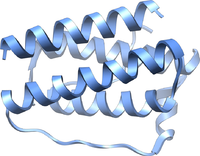
Photo from wikipedia
Obesity results from increased energy intake or defects in energy expenditure. Brown adipose tissue (BAT) is specialized for energy expenditure, a process called adaptive thermogenesis. Peroxisome proliferator–activated receptor γ coactivator… Click to show full abstract
Obesity results from increased energy intake or defects in energy expenditure. Brown adipose tissue (BAT) is specialized for energy expenditure, a process called adaptive thermogenesis. Peroxisome proliferator–activated receptor γ coactivator 1α (PGC1α) controls BAT-mediated thermogenesis by regulating the expression of Ucp1. Inhibitor of differentiation 1 (Id1) is a helix-loop-helix transcription factor that plays an important role in cell proliferation and differentiation. We demonstrate a novel function of Id1 in BAT thermogenesis and programming of beige adipocytes in white adipose tissue (WAT). We found that adipose tissue–specific overexpression of Id1 causes age-associated and high-fat diet–induced obesity in mice. Id1 suppresses BAT thermogenesis by binding to and suppressing PGC1α transcriptional activity. In WAT, Id1 is mainly localized in the stromal vascular fraction, where the adipose progenitor/precursors reside. Lack of Id1 increases beige gene and Ucp1 expression in the WAT in response to cold exposure. Furthermore, brown-like differentiation is increased in Id1-deficient mouse embryonic fibroblasts. At the molecular level, Id1 directly interacts with and suppresses Ebf2 transcriptional activity, leading to reduced expression of Prdm16, which determines beige/brown adipocyte cell fate. Overall, the study highlights the existence of novel regulatory mechanisms between Id1/PGC1α and Id1/Ebf2 in controlling brown fat metabolism, which has significant implications in the treatment of obesity and its associated diseases, such as diabetes.
Journal Title: Diabetes
Year Published: 2017
Link to full text (if available)
Share on Social Media: Sign Up to like & get
recommendations!